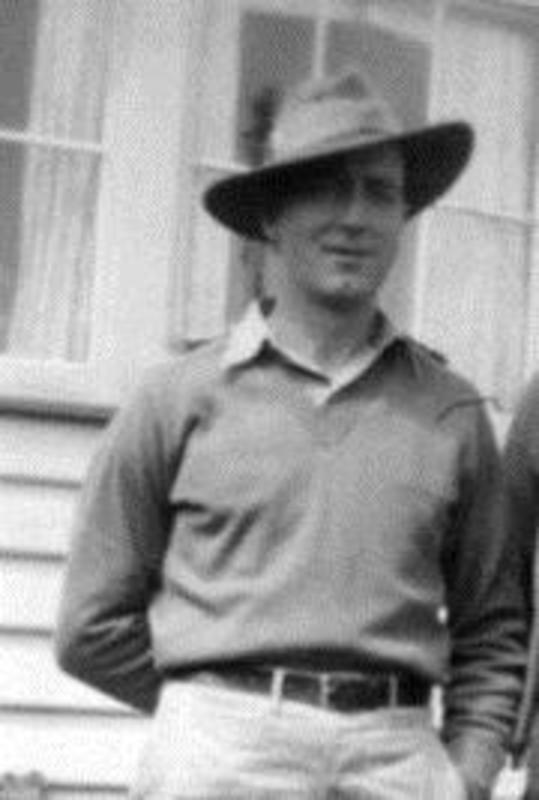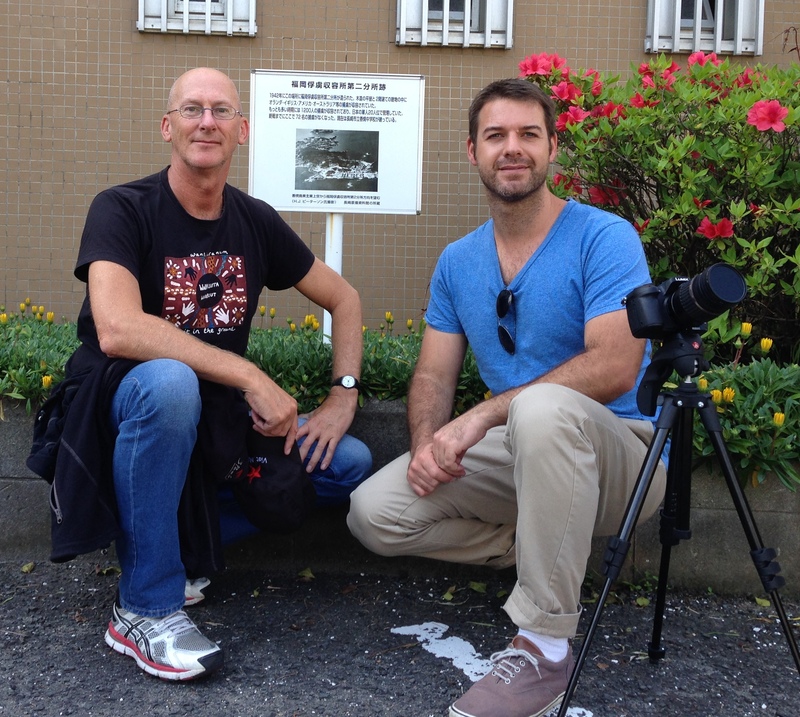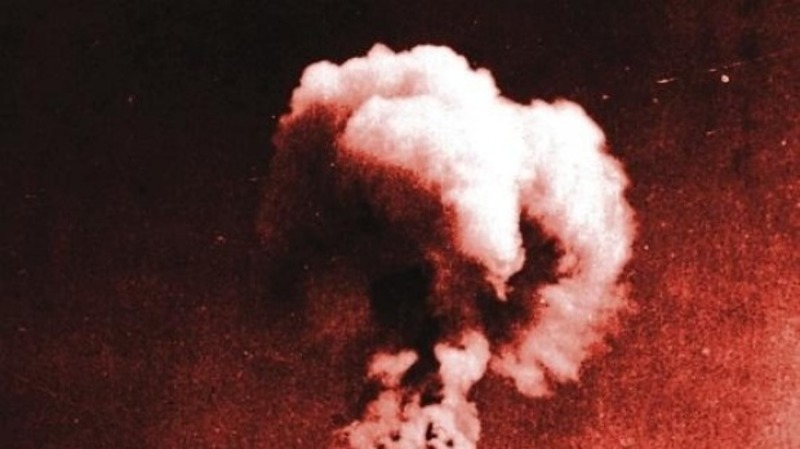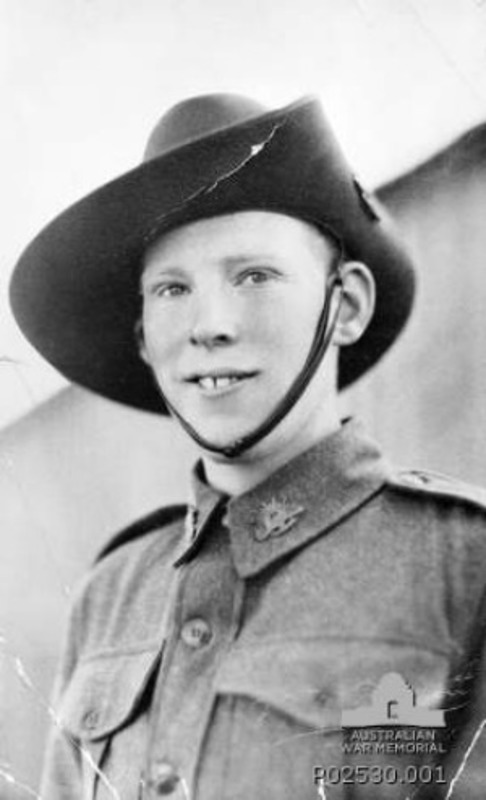Australian POWs and the Nagasaki A-Bombing
Mick Broderick
David Palmer’s timely opinion piece in The Melbourne Age on 6 August 2015 draws attention to the little remembered history of scores of Australian and other allied POWs who were held as slave labourers in Japanese war industries in Nagasaki before and at the time of the atom bombing. Aspects of this neglected history also form a major component of my recent multi-screen, hyper-visualisation exhibition “Fading Lights: Australian POW and BCOF Troops in Japan 1945-52”, co-curated with Stuart Bender (Curtin University).
|
In 1983 Former Australian POW and author Hugh V. Clarke (second from right) returned to the Fukuoka Camp No.2, a site now occupied by the Koyagi Junior High School adjacent to the former Kawanami Brothers Shipbuilding Company. Clarke is photographed alongside three of the former Camp prison guards, part of the Fading Lights exhibition backdrop incorporating digital overlays with contemporary images of the camp ground and school. [© Stuart Bender & Mick Broderick] |
Palmer’s efforts to have Australian soldier and Nagasaki POW, Private Alan Chick, officially recognized by the Japanese government ashibakusha, is especially commendable given that the award and medical entitlement occurred shortly before the former serviceman died last year. However, there was another Australian POW granted this status more than thirty years before.
At the time of the Nagasaki bombing Sergeant Peter McGrath-Kerr (2/40 Battalion) was also in Fukuoka Camp No 14 opposite the Mitsubishi steel foundry where he labored, alongside scores of other POWs. 1 Earlier that morning he and six comrades had toiled outdoors to repair a bridge over the Mifune Canal that had been destroyed in an air raid only eight days earlier (1 August). They had been sent back to the compound at around 10am for a rest break. McGrath-Kerr recalls that he was on his bunk reading a book when everyone began to bolt towards the air raid shelters.2 He awoke five days later, lying on a stretcher and saw that everything in sight was flattened. He had amnesia, five broken ribs and various cuts and bruises on his hands and legs.
|
Sergeant Peter McGrath-Kerr of 2/40th Battalion, who was taken prisoner by the Japanese and held in Java until May 1944. Sgt McGrath-Kerr was one of several hundred Australian, British and American POWs aboard the Tamahoko Maru en route to Japan when the ship was torpedoed and sunk by the US submarine Tang on 24 June 1944. One of only 212 survivors, he was transferred to the Fukuoka No. 12 POW camp in central Nagasaki. [AWM 045190] |
McGrath-Kerr, like Private Chick, was one of 24 Australian POWs at Camp No. 14 only 1.7 kms from the nuclear detonation. All miraculously survived. Had they been exposed outside directly in the line-of-sight of the explosion each would have likely perished. Others were not so lucky. At least four POWs were killed and around 30 seriously injured, mostly Dutch.3 A few others died as a result of their exposure in the following weeks. War-time correspondent Denis Warner in a 1995 op ed for the International Herald Tribune(reprinted in the New York Times) recalls speaking with McGrath-Kerr in a Manila hospital shortly after his transfer from Nagasaki. Warner found McGrath-Kerr “emaciated and weak”, still suffering from his broken ribs and “radiation burns on one hand”.
Another injured Australian soldier in the hospital, Sergeant Jack Johnson, also spoke with Warner. Johnson had been between two of the camp buildings when the bomb struck. Looking for fellow survivors amidst the smoke and debris he saw a pair of boots jutting out from under the rubble. It was the unconscious McGrath-Kerr. With fires igniting all round, Johnson worked hard to extract his compatriot and left him in the care of Dutch orderlies. In 1980 McGrath-Kerr returned to Japan as a guest of the City of Nagasaki where he was entitled to free medical treatment and officially recognized as an atom bomb victim (hibakusha).4
Video testimony of five Australian POWs, including Chick, is on display at the Nagasaki Atomic Bomb Museum. McGrath-Kerr’s testimony can be heard on the Australian War Memorial website.5
Remarkably, Private Chick, who survived both the harsh labor at Camp No. 14 and the Nagasaki atom bombing, returned to Japan only a few months after his liberation to be part of the British Commonwealth Occupation Forces. In 1948 he visited his former, now destroyed POW Camp and the Mitsubishi Foundry, and posed in uniform amongst former workers. He then served in the Korean War in the early 1950s.
|
Private Chick (crouching) with some of his former workers at the Mitsubishi foundry in Nagasaki, photographed while on BCOF duties. [AWM P00208.003 photo: Alan Chick] |
Like many of his generation, including amongst his POW peers, Chick maintained in his 1995 video testimony displayed at the Nagasaki museum that the atom bombs were necessary and entirely justifiable:
Well I’m all in favour of it, myself. As far as I’m concerned, it saved several million lives. I think that’s a very good argument in favour of it. I think, since the advent of the Bomb, we’ve had no more world wars. Like, before the Bomb, they had two world wars in twenty-five years. And now its fifty years [1995] and there’s been no world war. I consider it to have been a good thing, actually.
While not considered hibakusha, two other Australian POWs witnessed the Nagasaki explosion. On Koyagi Island, south of Nagasaki harbor, the POW camp (Fukuoka No.2) was adjacent to the Kawanami Brothers shipworks. In late-June 1945, most of the Australians were sent north of Nagasaki to work in the coal mine at Nakama, but two Australian soldiers, Bob Watkins and Joe Flynn remained due to illness.6 Both saw the “great flash […] a feeling of heat, huge noise of explosion, followed soon by a great rush of air, dust rose knee height caused by […] shock of concussion transmitted through the ground”.7
Watkins recalls looking up from ten kilometers away towards the mouth of Nagasaki harbor: “I was amazed to see this huge column of smoke and flame rising skywards forming into a distinct mushroom shape as it went”.8
 |
These accounts and the Nagasaki POW history remain little appreciated or recognized today. Similarly, the seven-year Australian BCOF presence (chiefly in the Hiroshima Prefecture) where more than 16,000 Australian troops rotated through Japan after the war, some bringing wives and families, is under-represented in military annals, especially in this centenary year of ANZAC commemorations.
Recent developments during the course of our research into and production of the Fading Lights exhibition were fortuitous. We learned during pre-production that a Nagasaki City Counciller, Mr Toyoichi Ihara (himself a hibakusha) was spearheading efforts by the local community to recognize the former POW camp on Koyagi. Mr Ihara, along with teachers, parents and students of the Junior High School that now occupies the site of the former POW Camp grounds, plan to erect a monument to the 73 soldiers, including 6 Australians, who died at the Camp during the war.9
|
Fading Light exhibition producers Mick Broderick and Stuart Bender in front of the current sign that notes the location of former POW camp No. 2 on the Koyagi Junior High school grounds. [© Mick Broderick & Stuart Bender] |
In April this year we sought permission to film inside the Nagasaki Mitsubishi plant, rebuilt after the atom bombing, on the location where Chick and 23 other Australian POWs survived the nuclear blast. Mr Ihara had informed us that there was a small commemorative plaque inside the plant attesting to the history of the POW workers. Unfortunately, we were denied entry to record at the factory for our exhibition.
However, a few months later in late July, news reports emerged that Mitsubishi was formally beginning the process of apologizing to POWs who were forced to work in their Nagasaki factories.10 A surviving American prisoner of war, 94 year-old James Murphy, traveled to Los Angeles to accept an apology from Mitsubishi Materials Corporation, describing what he endured as “slavery in every way”. A few days later, Mitsubishi’s spokesman Okamoto Yukio announced to the media “If there is such an opportunity, we will do the same apology” to other allied POWs including British, Dutch and Australian. Okamoto publicly admitted that his company was “one of those [that] tortured POWs most, so we have to apologize”.11
|
October 1945: former Nagasaki prisoners of war on their way home aboard HMS Formidable. Those named in bold were survivors of the atomic bomb at Camp 14, Nagasaki. Back row, left to right: QX14889 Lance Bombardier (L Bdr) Frederick Stuart Murray, 2/10 Field Regiment; not identified; QX17410 Gunner (Gnr) Charles Frederick Hancock, 2/10 Field Regiment; QX13595 L Bdr Garnet Johnson, 2/10 Field Regiment; not identified. Middle row, left to right: QX9907 Gnr Allan Richard Sidney Beitz, 2/10 Field Regiment; VX45894 Private (Pte) William Cecil Reed, 2/3 Machine Gun Battalion; TX3914 Pte Colin James Gleeson, 2/40 Infantry Battalion; NX47101 (246705) Lance Sergeant Ernest Roy Snowden, 2/12 Field Ambulance; VX53494 Pte Bernard Daniel O’Keefe, 2/40 Infantry Battalion; NX38456 L Bdr Francis William Fitzmaurice, 2/1 Heavy Battery; VX23630 Pte Eric Ernest Hooper, 2/2 Pioneer Battalion; TX4878 Gunner (Gnr) Charles Edward Howard, 2/1 Heavy Battery. Front row, left to right: QX17307 Bombardier Hugh Vincent Clarke, 2/10 Field Regiment; next four soldiers are not identified; VX25508 Pte Eric Murray Jobling, 18 Australian Anti Tank Battery; NX38462 Gnr Reginald McConnell, 2/1 Heavy Battery; VX41147 Pte Leslie Prendergast, 2/40 Infantry Battalion; VX25701 Pte Philip Joseph Smythe, 2/3 Machine Gun Battalion. [Australian War Memorial 045208] |
Nagasaki POWs: living under the shadow of the bomb
David Palmer
On August 6, 1945, 70 years ago, the world’s first nuclear war began with the dropping of an atomic bomb on Hiroshima, Japan. It unleashed the ongoing threat of annihilation under which the world still cowers.
|
This short video, shot and edited in 3D and viewable here in 2D, features the reflections of Ms Kana Miyoshi, a third-generation survivor (hibakusha) of the Hiroshima atomic bombing. She describes her “before and after” experiences of entering inside the UN’s World Heritage protected Genbaku Dome after producers Mick Broderick & Stuart Bender were granted special access in April 2015. |
Twenty-four Australian prisoners of war survived the atomic bombing of Nagasaki on August 9, 1945. Private Alan Chick, of St Helens, Tasmania, was one of them. But on that day when an American bomber dropped the last atomic bomb in the first nuclear war, it didn’t matter if you were Japanese or Australian, if you were a child, a Japanese general, or an Allied POW. Everyone within range of the bomb became a victim. More than 74,000 people died out of a population of 263,000, but some miraculously survived.
Chick and his battalion had been captured by the Japanese in Timor. He was eventually put on a ship bound for Japan, but a US submarine attacked this ship, sinking it along with hundreds of POWs. Chick survived with a few others and was picked up by a Japanese fishing boat off the Kyushu coast. He was taken to Nagasaki’s Fukuoka POW Camp 14 and put to work at a Mitsubishi steel foundry. His camp was less than two kilometres from the atomic bomb hypocentre on August 9. Knocked unconscious, he awoke to a world of complete black. When the smoke cleared he saw destruction, fires, and death everywhere. He had somehow survived again.
To make the atomic bombings into solely a national tragedy without reference to non-Japanese who also suffered is a grave error. The bombings were an international tragedy.
By 1944, hundreds of British, Dutch, Australian and American POWs worked as slave labourers in Mitsubishi’s massive shipbuilding complex in Nagasaki. Mitsubishi’s workforce also included thousands of Korean labourers taken by force from their homeland, who worked under armed guard at the shipyard, its many factories around the city, and in the company’s two coal mines on islands just off the coast.
|
A photo dated September 1945 of the remains of the Prefectural Industry Promotion Building after the bombing of Hiroshima, which was later preserved as a monument. Photo: AFP |
This month, three of these Nagasaki sites – the shipyard (still operating) and the coal mines (closed decades ago) – were approved by UNESCO for World Heritage listing. The listing of the shipyard and mines required extensive negotiations between Japan and South Korea on the Korean forced-labour issue, and agreement on a compromise historical wording was finally reached. Mitsubishi also publicly apologised for its use of POW labour at its many mine sites, but has yet to apologise to those POWs at other sites, including the Nagasaki shipbuilding complex.
Atomic bomb victims, known in Japan as hibakusha, have been eligible for full healthcare and living expenses paid by the Japanese government, but Koreans who returned to their homeland after World War II were refused these benefits. Japanese and Korean peace activists and atomic bomb survivors started a movement decades ago to change this injustice, which has led to many successful court cases in Japan.
In the last few years, Japanese researchers at the Nagasaki Overseas Hibakusha Network, led by Nobuto Hirano, have extended their hibakusha recognition movement to Allied POWs. Like the Korean hibakusha of Hiroshima and Nagasaki who also were forced labourers in Mitsubishi industries, Allied POWs were double victims: first as foreign forced labourers, and then as atomic bomb survivors. POWs were a substantial part of the labour force in Japan’s war production and coal mining from late 1944 until the surrender. Within Japan there were 130 POW camps holding more than 32,000 POWs. Of these about 3500 died in those camps and a further 11,000 died en route to Japan when ships carrying them were sunk by Allied submarines and planes.
|
The Nagasaki blast. |
There were 884 Allied POWs in the Nagasaki city region in two main POW camps: Koyagi Branch Camp (Fukuoka 2-B), on Koyagi Island in Nagasaki Harbour; and Nagasaki Mitsubishi Dockyard Branch Camp (Fukuoka 14-B) based in Saiwamachi (Urakami District). The Mitsubishi camp held 315 POWs. Of these, 113 died in the camp before the atomic bombing and seven died from the atomic bomb. Of the 195 POWs who survived at the end of the war, 152 were Dutch, 24 were Australian, and 19 were British. Alan Chick was held in Fukuoka Camp 14-B, next to Mitsubishi’s steel foundry.
The researcher, Hirano, contacted me through Hideto Kimura, a Nagasaki colleague I’ve known for many years, to locate former Australian POWs who survived the bombing. A few years earlier, Kimura and I had seen a video interview with Alan Chick at the Nagasaki Atomic Bomb Museum, taped in the 1980s. I found online documents in the Australian War Memorial Archives and National Archives of Australia detailing 24 repatriated Australian POWs who were in Nagasaki. Craig Collie, author of Nagasaki: The Massacre of the Innocent and Unknowing, had interviewed Chick in Heyfield, Victoria, which indicated where he might still be living.
I contacted the Returned and Services League in Heyfield and spoke with local RSL representative Sue Artso. She had been visiting Chick and his Japanese wife Anita (originally Hiroko) regularly in Heyfield’s aged-care home. When we made the trip to Heyfield, we interviewed Chick over three days.
|
An Allied correspondent stands in the rubble of a building that once was a movie theatre in Hiroshima, on Sepember 8, 1945, after the first nuclear weapon ever used in warfare was dropped by the US on August 6, 1945. Photo: Stanley Troutman |
I completed the necessary Japanese government forms in English for him so he could get atomic bomb survivor recognition and benefits. I then submitted these to the Japanese consulate in Melbourne, which forwarded them to Tokyo for review. Within weeks, two officials from Nagasaki City delivered his benefits book directly to him – in Heyfield. Without the initiative of Nagasaki peace activists and researchers, Chick would never have received this recognition. Chick was the only Australian POW of the surviving 24 incarcerated at Fukuoka Camp 14-B to ever receive the certificate from the Japanese government. Chick died in 2014, only a year after receiving the certificate, but receiving the survivor book and benefits was a final recognition of his status as an atomic bomb survivor and a former Australian POW who was in Nagasaki.
Chick supported the atomic bombing of Nagasaki because he believed it ended the war. But many historians now argue that the bombs were not the major factor behind the surrender because Japan’s industrial capacity had collapsed by mid-1945. The country had no access to raw materials, owing to Allied blockades. Finally, the invasion of Manchuria by the Soviet Red Army, the same day as the Nagasaki bombing, destroyed the fighting capacity of Japan’s Kwangtung Army, ending the power of the Japanese military.
Whatever position one takes, the legacy of the atomic bombings continues – through the many diseases of survivors from radiation exposure, the genetic impact on the second generation, and the far greater danger of nuclear weapons hundreds of times more powerful than the ones used on Hiroshima and Nagasaki.
|
Nagasaki survivor Alan Chick when he first entered the Army. |
The world also needs to understand that the victims of the atomic bombings were not only Japanese. In his Nagasaki address last year, Prime Minister Shinzo Abe stated: “We who experienced the agony of atomic bombings not once but twice have … raised ourselves to our feet once more, rebuilding our homeland and restoring Nagasaki as a beautiful city.”
To make the atomic bombings into solely a national tragedy without reference to non-Japanese who also suffered is a grave error. The bombings were an international tragedy, and the victims included Koreans and Allied POWs. Chick survived, and his survival is testament to the international character of the victims.
Mick Broderick is Associate Professor of Media Analysis in the School of Arts at Murdoch University and Deputy Director of the National Academy of Screen & Sound (NASS). Major publications include editions of the reference work Nuclear Movies (1988, 1991) and, as editor, Hibakusha Cinema: Hiroshima, Nagasaki and the Nuclear Image in Japanese Film (1996, 1999). Recent co-edited collections include Interrogating Trauma: Collective Suffering in Global Art and Media (2011) and Trauma, Media, Art: New Perspectives (2010).
Dr David Palmer is a visiting associate in history at the the University of Melbourne. He is the author of Organizing the Shipyards: Union Strategy in Three Northeast Ports, 1933-1945 (Cornell University Press) and works on Korean forced labor in wartime Japan.
Notes
1 Peter McGrath-Kerr, quoted in Hugh V. Clarke, 1984, Last Stop Nagaskai! Sydney, Allen & Unwin, p. 96. Denis Warner. 1995. ‘These Men Lived On to Tell a Ghastly Tale’. New York Times. 9 August.
2 Peter McGrath-Kerr, quoted in Hugh V. Clarke, 1984, Last Stop Nagaski! Sydney, Allen & Unwin, p. 96. Denis Warner. 1995. ‘These Men Lived On to Tell a Ghastly Tale’. New York Times. 9 August.
3 Edlington, David. 1995. “An incandescent flash of death”, The Canberra Times, 27 July, p. 11 .
4 Clarke, Last Stop Nagaskai! p. 130. See also “Free medicine for POWs”, The Canberra Times, 14 August 1980, p. 7.
5 “Peter McGrath-Kerr as a sergeant 2/40th Australian Infantry Battalion and a prisoner of the Japanese, 1940-1945, interviewed by Tim Bowden”
6 Clarke, Last Stop Nagaskai!, pp. 105-109.
7 Clarke, Last Stop Nagaskai!, pp. 106.
8 Ibid.
9 Okada Gen, 2014, “Nagasaki residents seek to remember POWs who died in local camp”, Asahi Shimbun, 29 January
10 BBC News online, 2015 “Japan’s Mitsubishi makes prisoners of war apology”
11 Associated Press, 2015, “Mitsubishi to apologise to POWs”, 22 July
Recommended citation: Mick Broderick and David Palmer, “Australian, British, Dutch and U.S. POWs: Living under the shadow of the Nagasaki Bomb”, The Asia-Pacific Journal, Vol. 13, Issue 32, No. 3, August 10, 2015.












